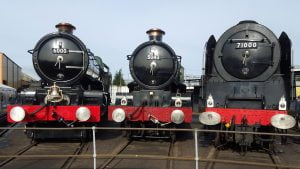This week's Sole Survivor will be looking at the BR Class 8 steam locomotive, which are 4-6-2 tender engines, and is 71000 Duke of Gloucester. Once we have looked at their working life, we will then look at the preservation history of the only member left.
BR Class 8 locomotive

In 1954, there became the need for a replacement to 46202 Princess Anne, which was involved in the Harrow and Wealdstone Rail Disaster. The locomotive was subsequently destroyed in the crash.
The BR Class 8 class of steam locomotive only ever had one locomotive built, this being the prototype, 71000 Duke of Gloucester.
The basic dimensions for the class include: 4-6-2 wheel arrangement (leading wheels – 3ft, driving wheels of 6ft 2 in and trailing truck – 3ft 3.5in), boiler pressure of 250 psi, three cylinders (18 x 28 in size), total weight came in at 156.75 long tons and a tractive effort of 39,080 lbf.
Productive Series
- Prototype – 71000 Duke of Gloucester – built April 1954 at Crewe Works.
Performance in Service
71000 Duke of Gloucester, or The Duke as it was popularly known, was based on the BR Britannia Class. It incorporated three sets of modified Caprotti valve gear, which was more efficient than Walschaerts or Stephenson valve gear.
Unfortunately, crews which worked on the locomotive regarded it as a failure. This is due to its poor steaming and heavy fuel consumption.
When British Rail undertook trials with the locomotive, the locomotive also returned negative feedback. Problems that were reported included poor draughting of the locomotive, this resulted in difficulty adhering to the timetable.
71000 Duke of Gloucester had its working life at Crewe North Depot and worked on the undemanding North Wales Coat Line between Crewe and Holyhead.
Decline and Withdrawal
When 71000 Duke of Gloucester entered service, British Rail was starting to circulate its Modernisation Plan, which included the start of the diesel era. This meant that the problems which 71000 had, including the poor steaming and heavy fuel consumption, were not rectified.
This led to the locomotive having a working life of just 8 years. It was withdrawn in 1962 and was sent to the Woodham Bros Scrapyard, in Barry, South Wales.
Preservation
National Collection
The Sole Survivor of the class is, oddly, the only one being built, this being 71000 Duke of Gloucester. The locomotive was first picked to be in the National Collection, however, it was decided that only the cylinder arrangement was of interest. One of them was put on display at the Science Museum, the other was removed to make the locomotive balanced and was prepared for scrapping.
The locomotive was purchased by Dai Woodham. The locomotive was initially sent to the wrong scrapyard, however, once at the right scrapyard, it was stored there for many years.
The Duke of Gloucester Steam Locomotive Trust
In 1974, a group of volunteers bought the locomotive and formed The Duke of Gloucester Steam Locomotive Trust. Overhaul started straight away, however, with many of the components missing, it took 13 years to complete and return to steam.
Whilst the overhaul and restoration was taking place, some of the problems which were found in operational use with British Rail were fixed. Here is what they found:
- The locomotive's chimney was too small compared with locomotives of similar size. This resulted in poor draughting when high steam was in demand.
- The firebed air inlet dampers were not to the drawings and were too small. This resulted in the poor air supply and inefficient coal burning.
These errors were corrected during the overhaul. Improvements were also made during the restoration, this included the Kylchap exhaust system. When the locomotive first hauled a train on the mainline in preservation, it soon became clear that the locomotive was now producing steam at a more efficient rate. Ironically, it is now more powerful than the EE Type 4 types of diesel that replaced The Duke in service. In 1995, at the Shap Trials, the locomotive broke the record for the fastest northbound ascent.
In preservation, the locomotive is one of the most efficient and powerful steam locomotives to ever run in Britain. It has since seen regular use on the mainline.
Overhaul
The BR Class 8 Steam Locomotive Trust is currently working on overhauling the locomotive at Tyseley Locomotive Works, this is hoped to be completed soon. You can donate to the overhaul by clicking here.
We hope you have enjoyed discovering more about 71000 ‘Duke of Gloucester' in this week's Sole Survivor. Two weeks time we shall be back again with another Sole Survivor. Both a Lost Class and Class Information will be able to be read in the meantime.
- Visit the RailAdvent news homepage
For the latest railway news - Visit the RailAdvent Shop
For railway related goodies! - Visit LocoStop – Our New Social Network
Come and share your photo's and video's, join the discussion.
Find out what others are sharing